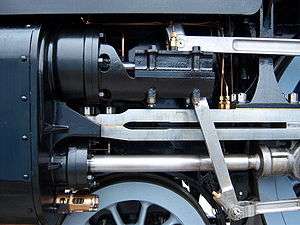Cylinder (locomotive)

The cylinders of a steam locomotive are the components that convert the power stored in the steam into motion.
Cylinders may be arranged in several different ways.
Early locomotives
On early locomotives, such as Puffing Billy, the cylinders were often set vertical and the motion was transmitted through beams, as in a beam engine.
Direct drive
The next stage, for example Stephenson's Rocket, was to drive the wheels directly from steeply inclined cylinders placed at the back of the locomotive. Direct drive became the standard arrangement, but the cylinders were moved to the front and placed either horizontal or nearly horizontal.
Inside or outside cylinders
The front-mounted cylinders could be placed either inside (between the frames) or outside. Examples:
- Inside cylinders, Planet locomotive
- Outside cylinders, GNR Stirling 4-2-2
In the 19th and early 20th centuries, inside cylinders were widely used in the UK, but outside cylinders were more common in Continental Europe and the United States. The reason for this difference is unclear. From about 1920, outside cylinders became more common in the UK but many inside-cylinder engines continued to be built.
Inside cylinders give a more stable ride with less yaw or "nosing" but access for maintenance is more difficult. Some designers used inside cylinders for aesthetic reasons.
Three or four cylinders
The demand for more power led to the development of engines with three cylinders (two outside and one inside) or four cylinders (two outside and two inside). Examples:
- Three cylinders, SR Class V, LNER Class A4
- Four Cylinders, LMS Princess Royal Class
Crank angles
On a two-cylinder engine the cranks, whether inside or outside, are set at 90 degrees. As the cylinders are double-acting (i.e. fed with steam alternately at each end) this gives four impulses per revolution and ensures that there are no dead centres.
On a three-cylinder engine, two arrangements are possible:
- cranks set to give six equally spaced impulses per revolution – the usual arrangement. If the three cylinder axes are parallel, the cranks will be 120 degrees apart, but if the centre cylinder does not drive the leading driving axle, it will probably be inclined (as on most US three-cylinder locomotives and on some of Gresley's three-cylinder locomotives in Great Britain), and the inside crank will be correspondingly shifted from 120 degrees.
- outside cranks set at 90 degrees, inside crank set at 135 degrees, giving six unequally spaced impulses per revolution. This arrangement was sometimes used on three-cylinder compound locomotives which used the outside (low pressure) cylinders for starting. This will give evenly spaced exhausts when the engine is working compound.
Two arrangements are also possible on a four-cylinder engine:
- all four cranks set at 90 degrees. With this arrangement the cylinders act in pairs, so there are four impulses per revolution, as with a two-cylinder engine.
- pairs of cranks set at 90 degrees with the inside pair set at 45 degrees to the outside pair. This gives eight impulses per revolution. It increases weight and complexity, by requiring four sets of valve gear, but gives smoother torque and reduces the risk of slipping.
Valves
The valve chests or steam chests which contain the slide valves or piston valves may be located in various positions.
Inside cylinders
If the cylinders are small, the valve chests may be located between the cylinders. For larger cylinders the valve chests are usually on top of the cylinders but, in early locomotives, they were sometimes underneath the cylinders.
Outside cylinders
The valve chests are usually on top of the cylinders but, in older locomotives, the valve chests were sometimes located alongside the cylinders and inserted through slots in the frames. This meant that, while the cylinders were outside, the valves were inside and could be driven by inside valve gear.
Valve gear
There are many variations in the location of the valve gear. In British practice, inside valve gear is usually of the Stephenson type while outside valve gear is usually of the Walschaerts type. However, this is not a rigid rule and most types of valve gear are capable of being used either inside or outside. Joy valve gear was once popular, e.g. on the LNWR G Class.
Inside cylinders
On inside-cylinder engines the valve gear is nearly always inside (between the frames), e.g. LMS Fowler Class 3F.
Outside cylinders
On engines with outside cylinders there are three possible variations:
- Inside valve gear driving inside valves, e.g. NER Class T2
- Inside valve gear driving outside valves through rocking shafts, e.g. GWR 4900 Class
- Outside valve gear driving outside valves, e.g. LSWR N15 Class
Three cylinders
There are three common variations:
- Three sets of valve gear (two outside, one inside), e.g. LNER Peppercorn Class A2
- Outside valve gear driving the outside valves. Inside valve driven by Gresley conjugated valve gear, e.g. LNER Class A1/A3
- Three sets of inside valve gear (all valves inside), e.g. NER Class T3
Four cylinders
There are three common variations:
- Four sets of valve gear (two outside, two inside), e.g. SR Lord Nelson Class
- Inside valve gear driving the inside valves directly and the outside valves via rocking shafts, e.g. GWR 4073 Class
- Outside valve gear driving the outside valves directly and the inside valves via rocking shafts, e.g. LMS Princess Coronation Class
Other variations
There are many other variations, e.g. geared steam locomotives which may have only one cylinder. The only conventional steam locomotive with one cylinder that is known is the Nielson One-Cylinder Locomotive.[1]
See also
References
- ↑ Self, Douglas (27 May 2003). "The Nielson One-Cylinder Locomotive.". Retrieved 2 December 2010.